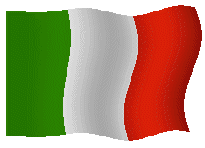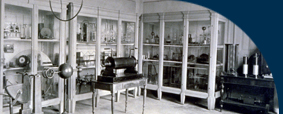
 |
Clarke's magneto-electric machine |
 |
Macchina magneto-elettrica di Clarke |
| Subject: electromagnetism/electrotherapy |
Settore: elettromagnetismo/elettroterapia, esperienze varie |
| Number of catalogue: 34 |
Numero di inventario: 34 |
| Engraved on a brass plate of the base: "F. de Palma Napoli" |
Su un'etichetta d'ottone della base: "F. De Palma Napoli" [inciso] |
| 1871 [document] |
Periodo di costruzione: 1871 [documento] |
| £ 390 [document] |
Prezzo d'acquisto: £ 390 [documento] |
| Beech, walnut, brass, iron, glass, ebonite, silk |
Materiali utilizzati: Rovere, noce, ottone, ferro, vetro, ebanite, seta |
| 372 X 190 X 500 [mm] |
Dimensioni: 372 X 190 X 500 [mm] |
| |
|
Including: a couple of two horseshoe-shaped electromagnets with different thickness and windings |
Annessi: due coppie di elettromagneti a ferro di cavallo con spessori e numero di avvolgimenti differenti. |
| |
|
Accessories: two brass hollow cylinders (electrodes), voltameter, brass capsule, brass frame with platinum wire, condenser, horse shoe-shaped electromagnet
|
Accessori: due elettrodi cilindrici, voltametro, capsula d'ottone, telaio d'ottone con filo di platino, condensatore, elettromagnete. |
| |
|
From the discovery of the bill of purchase it is evident that this elegant machine, which was built by the Neapolitan mechanician Filippo De Palma, was purchased by Serpieri at the cost of £ 390 and came to Urbino on May 1, 1871. The origin of this machine derives from the discovery of electromagnetic induction made in 1831 by the English physicist Michael Faraday that resulted immediately in practical applications. Among them there was the invention and creation of some magneto-electric generators that were able to transform mechanical energy into electrical energy using fixed permanent magnets. The first machine was projected by the Parisian instrument-maker Hippolyte Pixii in 1832, and it was then followed by the model suggested by the American maker Joseph Saxton (1833) and by the model presented by Edward Marmaduke Clarke (1806-1859), an instrument-maker of Irish origin from London. The last model, the first description of which dates to October 1836, was a success on the market and became very popular among Victorian families and in laboratories as well, for its presumed and proclaimed electrotherapeutic effects. With its accessories many significant experiences were shown. |
Dal ritrovamento della fattura d'acquisto sappiamo che questa bella macchina, costruita dal meccanico napoletano Filippo de Palma, fu acquistata dal Serpieri al prezzo di £ 390 ed arrivò in Urbino il 1 maggio 1871. Essa trasse la sua origine dallla scoperta, avvenuta nel 1831, dell'induzione elettromagnetica da parte del fisico inglese Michael Faraday che stimolò immediate applicazioni pratiche. Tra queste, l'ideazione e la costruzione di alcuni generatori magneto-elettrici in grado di convertire, sfruttando magneti permanenti fissi, l'energia meccanica in energia elettrica. La prima macchina fu ideata dal costruttore parigino Hippolyte Pixii nel 1832, seguita dal modello proposto dal costruttore americano Joseph Saxton (1833) e da quello del costruttore londinese di origine irlandese Edward Marmaduke Clarke (1806-1859). Quest'ultimo modello, la cui prima descrizione è dell'ottobre del 1836, si impose commercialmente e divenne molto popolare nelle famiglie vittoriane e nei laboratori, per i suoi presunti e conclamati effetti elettroterapeutici; con i suoi accessori si potevano mostrare anche numerose esperienze significative. |
| |
|
Description: The machine is mounted upon a beech frame in a protective by a chestnut box with a special shelf on which the accessories can be stored. The instrument consists of a series of horseshoe shaped nickel-plated iron bars, which are highly magnetised and vertically fixed onto a wooden board with a brass screw. A horizontal shaft (the rotor), projecting through the vertical board, is manually rotated by the crank of a cogged wheel the cogs of which enter the rings of an endless chain. On one extremity the shaft has a pair of copper coils covered with silk and which are wrapped in one way and linked by their extremities and wrapped in the opposite direction on two soft iron cylinders. These are connected at the front with a small soft iron bar and their extremities in the back, which are the poles of the electromagnet, rotate and pass repeatedly near the opposite poles of the series of magnets. This consists of a cylinder, which is insulated by ebonite and surrounded by two brass semi-rings (the collector). These are electrically connected with the two coils and are in contact with two iron springs that communicate alternately with each of them during every semirevolution. The iron springs, of which there are three altogether, fit into the holes of two brass strips, which are insulated one from the other by a wooden wedge base and which are provided with two rheofores for adding other accessories. The machine has two pairs of different coils: the former has some thin, long thread, which is apt to make high-tension physiological and chemical experiments; the latter has some short and thick thread for the caloric and luminous effects produced by strong currents. |
Descrizione: la macchina, montata su un telaio in mogano e protetta da una scatola di rovere avente un apposito scomparto per riporvi gli accessori, si compone di un fascio di sbarre di ferro nichelato a forma di ferro di cavallo, fortemente calamitate, fissate verticalmente su una tavoletta di mogano tramite una vite d'ottone. Un asse orizzontale (il rotore) che attraversa la tavoletta verticale, viene messo in rotazione manualmente dal manubrio di una ruota dentata i cui denti penetrano negli anelli di una catena perpetua. L'asse porta ad un estremo una coppia di bobine di filo di rame ricoperte di seta, unite per i loro estremi ed avvolte in senso inverso su due cilindri di ferro dolce. Una sbarretta, anch'essa di ferro dolce, connette anteriormente i due cilindri le cui estremità posteriori, costituenti i poli dell'elettromagnete, ruotando, passano e ripassano vicino ai poli opposti del fascio dei magneti. Un commutatore rotante, posizionato lungo l'asse di rotazione delle bobine, è costituito da un cilindro isolato con dell'ebanite e circondato da due mezzi anelli d'ottone (il collettore), connessi elettricamente alle due bobine ed in contatto strisciante con due mollette di ferro che comunicano alternativamente con ciascuno di essi durante ogni mezzo giro. Le mollette di ferro (tre in tutto), si incastrano nei fori di due strisce d'ottone isolate tra loro da uno zoccolo di legno e dotate di due serrafili per la connessione di vari accessori. La macchina è provvista di due coppie di bobine diverse: l'una a filo lungo e sottile, idonea per le esperienze fisiologiche e chimiche ad alta tensione; l'altra a filo corto e spesso per gli effetti calorifici e luminosi prodotti da forti correnti. |
| |
|
Function: By rotating the two coils, an induced current is generated that at every semirevolution changes direction when the coils pass near the pole of the magnet with the opposite polarity. The machine, therefore, receives alternated currents from the two coils, which can be compared to a pair of piles connected with each other, with the poles of the same kind but in which every pole changes its polarity at every semirevolution. The current produced in this way can be rectified with a rotating commuter. The following accessories are included: a pair of cylindrical brass electrodes that, when held by the patient in his hands, give him repeated electric shocks; a voltameter for the decomposition of water into hydrogen and oxygen; a brass capsule to ignite ether; a brass frame upon which there is a thin platinum thread, and a condenser, which is covered on one side by tin paper to show the incandescence; a horseshoe-shaped electromagnet for the magnetization of iron. |
Funzionamento: mettendo in rotazione le due bobine esse generano ciascuna una corrente indotta che, ad ogni semirivoluzione, cambia senso ogniqualvolta passano vicino al polo di opposta polarità del magnete. La macchina dunque raccoglie correnti alternate dalle due bobine che possono essere paragonate a una coppia di pile connesse tra loro per i poli dello stesso segno ma nelle quali ciascun polo cambia di segno per ogni semirivoluzione. La corrente così prodotta può essere raddrizzata dal commutatore rotante. Sono presenti i seguenti accessori: una coppia di elettrodi cilindrici d'ottone che, tenuti in mano, somministrano al paziente ripetute commozioni elettriche; un voltametro per la decomposizione dell'acqua in idrogeno ed ossigeno; una capsula d'ottone per infiammare l'etere; un telaio d'ottone su cui è teso un fine filo di platino; un condensatore con una faccia ricoperta di stagnola per mostrare l'incandescenza; un elettromagnete a ferro di cavallo per la magnetizzazione del ferro. |
| |
|
Bibliography: Clarke [1836], pp. 262-266; Ganot [1855], pp. 682-685; Luvini [1862], pp. 456-457; Acts of the Commission [1872-1873], Urbino University Library, envelope 13, file 7; Burnett, Morrison-Low [1989], p. 66. |
Bibliografia: Clarke [1836], pp. 262-266; Ganot A. [1855], pp. 682-685; Luvini G. [1862], pp. 456-457; Atti della Commissione [1872-73], Archivio dell'Università di Urbino, Busta 13, fasc. 7; Burnett, Morrison-Low [1989], p. 66. |
|
|

